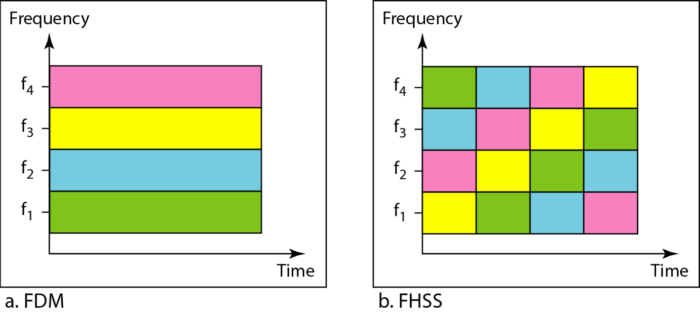Wireless Communication and Spread Spectrum

November 1, 2016
Categorised in: Data Communicaiton & Wireless Sensor Networks
What is Wireless Communication ?
Transmitting voice and data using electromagnetic waves in open space (atmosphere)
Electromagnetic waves
- Travel at speed of light (c = 3×108 m/s)
- Has a frequency (f) and wavelength (LAMBDA)
» c = f x LAMBDA - Higher frequency means higher energy photons
- The higher the energy photon the more penetrating is the radiation
Types of wireless communication

Point-to-Point Communication: Cellular
Multipoint Communication: Wireless Computer Network
Broadcast Communication: Radio Service
Electromagnetic Waves & Electromagnetic Spectrum
Transverse waves without a medium! (They can travel through empty space)

They travel as vibrations in electrical and magnetic fields.
— Have some magnetic and some electrical properties to them.

When an electric field changes, so does the magnetic field. The changing magnetic field causes the electric field to change. When one field vibrates—so does the other.
RESULT-An electromagnetic wave.
Waves or Particles? Electromagnetic radiation has properties of waves but also can be thought of as a stream of particles.
Example: Light
- Light as a wave: Light behaves as a transverse wave which we can filter using polarized lenses.
- Light as particles (photons): When directed at a substance light can knock electrons off of a substance (Photoelectric effect)
Electromagnetic Spectrum—name for the range of electromagnetic waves when placed in order of increasing frequency
Wavelengths

Electromagnetic Spectrum

Radio Waves
Have the longest wavelengths and lowest frequencies of all the electromagnetic waves.
Global Positioning Systems (GPS) measures the time it takes a radio wave to travel from several satellites to the receiver, determining the distance to each satellite.
A radio picks up radio waves through an antenna and converts it to sound waves.
— Each radio station in an area broadcasts at a different frequency.
MRI (MAGNETIC RESONACE IMAGING)
Uses Short wave radio waves with a magnet to create an image.
MICROWAVES
Have the shortest wavelengths and the highest frequency of the radio waves. Used in microwave ovens. Waves transfer energy to the water in the food causing them to vibrate which in trn transfers energy in the form of heat to the food.
RADAR (Radio Detection and Ranging)
Used to find the speed of an object by sending out radio waves and measuring the time it takes them to return.
INFRARED RAYS
Infrared= below red
Shorter wavelength and higher frequency than microwaves.
Thermogram—a picture that shows regions of different temperatures in the body. Temperatures are calculated by the amount of infrared radiation given off.
•Therefore people give off infrared rays.
•Heat lamps give off infrared waves.
VISIBLE LIGHT
Shorter wavelength and higher frequency than infrared rays.
Electromagnetic waves we can see.
Longest wavelength = red light
Shortest wavelength = violet light
Spread Spectrum Systems
- Analog or digital data
- Analog signal
- Spread data over wide bandwidth
- Makes jamming and interception harder
- Frequency hoping
- Signal broadcast over seemingly random series of frequencies
- Direct Sequence
- Each bit is represented by multiple bits in transmitted signal
- Chipping code
In spread spectrum (SS), we combine signals from different sources to fit into a larger bandwidth, but our goals are to prevent eavesdropping and jamming. To achieve these goals, spread spectrum techniques add redundancy.
- Frequency Hopping Spread Spectrum (FHSS)
- Direct Sequence Spread Spectrum (DSSS)
A signal that occupies a bandwidth of B, is spread out to occupy a bandwidth of Bss
All signals are spread to occupy the same bandwidth Bss
Signals are spread with different codes so that they can be separated at the receivers.
Signals can be spread in the frequency domain or in the time domain.

Frequency hopping spread spectrum (FHSS)

Frequency selection in FHSS

FHSS cycles

Bandwidth Sharing

DSSS

DSSS example

- Input fed into channel encoder
- Produces narrow bandwidth analog signal around central frequency
- Signal modulated using sequence of digits
- Spreading code/sequence
- Typically generated by pseudonoise/pseudorandom number generator
- Increases bandwidth significantly
- Spreads spectrum
- Receiver uses same sequence to demodulate signal
- Demodulated signal fed into channel decoder
General Model of Spread Spectrum System

Gains
- Immunity from various noise and multipath distortion
- including jamming
- Can hide/encrypt signals
- Only receiver who knows spreading code can retrieve
signal
- Only receiver who knows spreading code can retrieve
- Several users can share same higher bandwidth with little interference
- Cellular telephones
- Code division multiplexing (CDM)
- Code division multiple access (CDMA)
Pratik Kataria is currently learning Springboot and Hibernate.
Technologies known and worked on: C/C++, Java, Python, JavaScript, HTML, CSS, WordPress, Angular, Ionic, MongoDB, SQL and Android.
Softwares known and worked on: Adobe Photoshop, Adobe Illustrator and Adobe After Effects.
